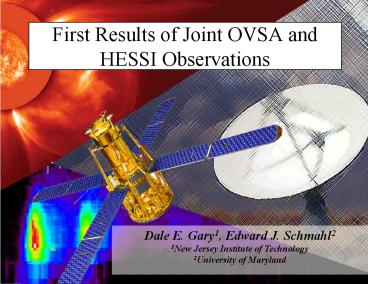First Results of Joint OVSA and HESSI Observations - PowerPoint PPT Presentation
Title:
First Results of Joint OVSA and HESSI Observations
Description:
... in several acceleration episodes, apparently independently of the ... In first acceleration episode, 25 keV X-rays progressively harden (from d ~ 7.5-4.7) ... – PowerPoint PPT presentation
Number of Views:20
Avg rating:3.0/5.0
Title: First Results of Joint OVSA and HESSI Observations
1
First Results of Joint OVSA and HESSI Observations
Dale E. Gary1, Edward J. Schmahl2 1New Jersey
Institute of Technology 2University of Maryland
2
Joint Observations of Five Solar Bursts
- We present 5 solar bursts observed jointly in
microwaves with Owens Valley Solar Array (OVSA)
and in hard X-rays with the Ramaty Hi-Energy
Solar Spectroscopic Imager (RHESSI). - A spectral comparison of the 5 bursts in both
microwaves and hard X-rays is presented in the
accompanying figures. - We examine one event, 2002 Mar 18, in more
detail, both spectrally and spatially.
3
2002 Feb 20
4
2002 Feb 23
5
2002 Feb 25
6
2002 Mar 18
7
2002 Mar 29
8
- Ask to see this animation of the RHESSI spectrum
for the 2002 Mar 18 burst on a laptop computer!
9
OVSA Radio Spectra (2002 Mar 18)
10
Spectral Results (2002 Mar 18)
- Thermal part of X-ray emission rises and falls
relatively smoothly. - gt 25 keV X-rays vary in several acceleration
episodes, apparently independently of the thermal
emission. - In first acceleration episode, gt 25 keV X-rays
progressively harden (from d 7.5-4.7) . - At the same time, the OVSA spectral peak
increases monotonically. - Spectral peak can increase due to three effects
increase in NL, increase in B, or decrease in d
(Dulk 1985).
11
RHESSI Images (2002 Mar 18)
12-25 keV
25-50 keV
12
BBSO Context (2002 Mar 18)
13
Spatial Results (2002 Mar 18)
- Thermal part of X-ray emission fills a small
loop, about 20 long. - gt 25 keV X-rays come from a smaller source at one
end of the loop. - OVSA source is compact, and all frequencies
appear to be nearly cospatial.
14
Conclusions
- After only four months OVSA and RHESSI have
jointly observed at least a dozen events. - We have presented some preliminary comparisons of
5 events. - The outstanding spectral resolution of RHESSI
allows detailed comparison with OVSA microwave
spectra. - The thermal components seen by RHESSI are only
weakly detected with OVSA. - Comparisons of spatial source structure have not
yet been done, but will be done as soon as
possible.































